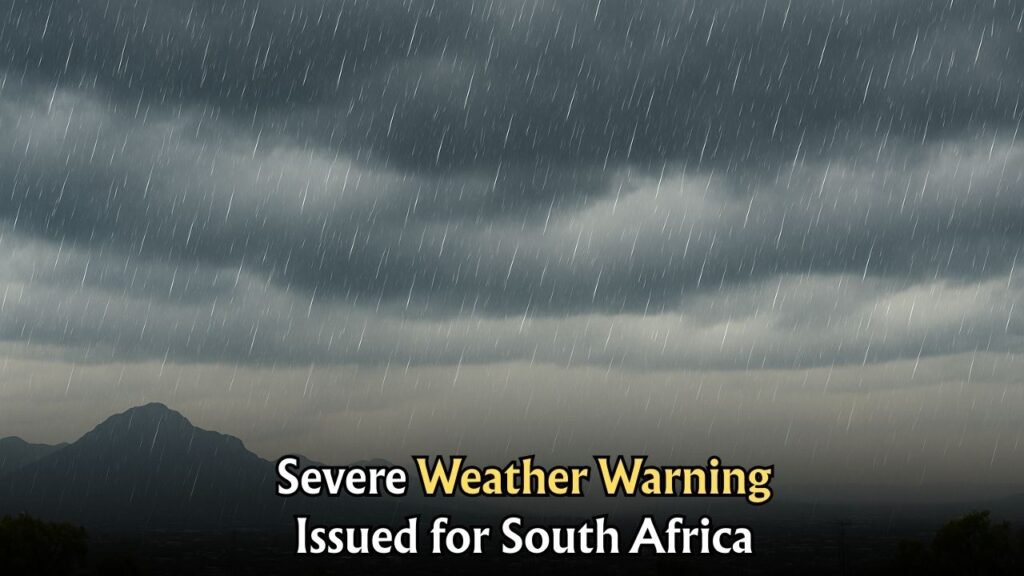South Africa on High Alert: As the nation braces for impending weather challenges, the South African government has issued a stern warning about severe rainstorms expected to hit various regions. With the climate patterns becoming increasingly unpredictable, citizens are urged to remain vigilant and prepare adequately for the heavy rainfall forecasted. The alert comes in light of recent weather disruptions that have caused significant damage, and this serves as a crucial reminder of the importance of being prepared for natural calamities. Residents in low-lying areas are particularly advised to take necessary precautions as the rainstorms could lead to potential flooding, posing a threat to both property and life. The government emphasizes the need for community cooperation and responsiveness to official advisories to ensure safety and minimize damage.

Understanding the Severity of South Africa’s Forecasted Rainstorms
The announcement of severe rainstorms in South Africa has not been made lightly. Meteorological experts have analyzed the current weather systems, which include a confluence of atmospheric conditions conducive to heavy rainfall. These conditions are reminiscent of previous instances where intense rainfall led to widespread flooding and disruption. The government’s proactive stance in issuing this alert underscores the gravity of the situation. With heavy rains, the risk of flash flooding increases, especially in regions with poor drainage systems. These floods can sweep away vehicles, damage homes, and disrupt everyday life. Residents are urged to monitor local weather reports and heed any evacuation orders or safety instructions issued by authorities. In addition, it’s vital for individuals to ensure that their insurance policies are up-to-date and that they have emergency kits prepared, including essentials like water, non-perishable food, and medical supplies.
Government Measures in Place for Rainstorm Preparedness
In response to the impending threat, the South African government has outlined several measures to mitigate potential impacts. Key among these is the activation of disaster management centers across the country, ready to coordinate swift responses to any emergencies that may arise. Authorities have also increased patrols in vulnerable regions to facilitate rapid evacuation if necessary. Infrastructure checks are underway to ensure that bridges, roads, and drainage systems are capable of handling the increased water flow. Moreover, public awareness campaigns are actively informing citizens about safety measures and encouraging community preparedness. The government is working closely with local municipalities to ensure that resources such as sandbags and emergency shelters are available to those in need. By taking these steps, the government aims to safeguard lives and reduce the economic impact of the rainstorms.
Community’s Role in Facing Severe Weather Challenges in South Africa
Community involvement is paramount in facing the severe rainstorms predicted in South Africa. Local communities are encouraged to establish emergency plans that include communication strategies and safe meeting points. Neighbours should check in on each other, especially vulnerable individuals such as the elderly or those with disabilities, to ensure they are safe and informed. Furthermore, participating in local emergency drills can enhance community readiness and cohesion. Social media platforms and community radio stations are excellent tools to disseminate information quickly and efficiently. By fostering a culture of preparedness and mutual aid, communities can significantly enhance their resilience against natural disasters. Sharing resources and knowledge about flood safety can also empower individuals to take proactive steps in protecting themselves and their properties.
Long-term Strategies to Combat Future Weather Extremes in South Africa
While immediate actions are crucial, long-term strategies are equally important in combating future weather extremes in South Africa. Climate change has made weather patterns increasingly erratic, necessitating a shift towards sustainable and resilient infrastructure. Investment in improved drainage systems, flood barriers, and green spaces can help mitigate the impact of heavy rains. Furthermore, urban planning should incorporate climate resilience, ensuring that development projects consider potential weather risks. Education and public awareness on climate change and its effects can empower citizens to make informed decisions and advocate for policies that prioritize environmental sustainability. By adopting these strategies, South Africa can better prepare for and adapt to the challenges posed by severe weather, ensuring the safety and well-being of its citizens now and in the future.




